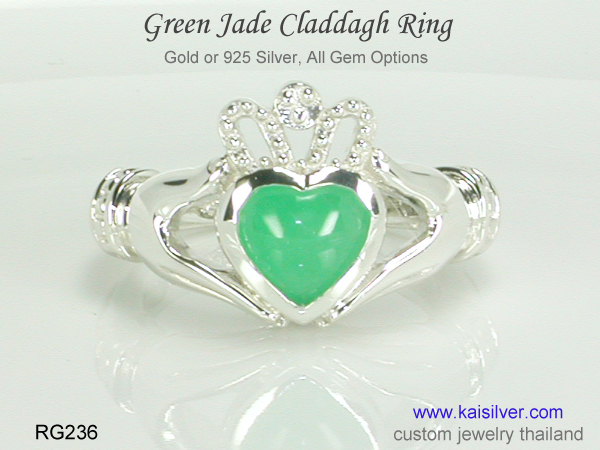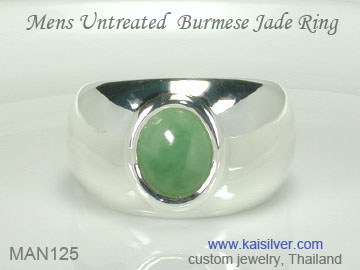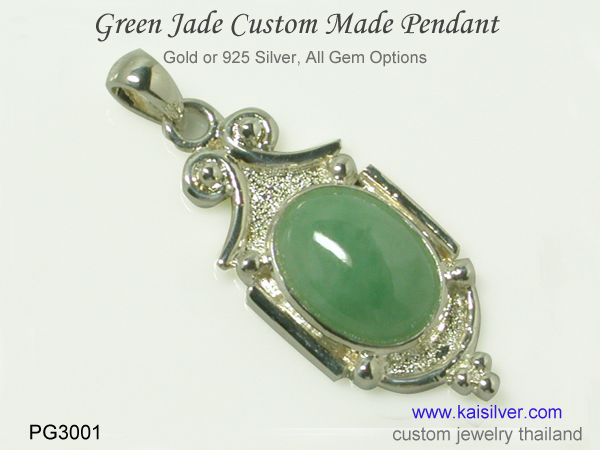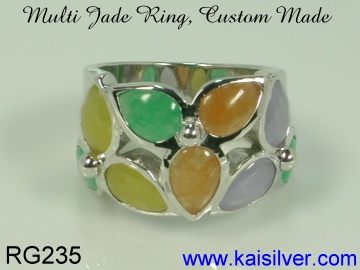Kaisilver Jade Rings
Mankind has known jade for many centuries and yet the earliest applications of jade were not related to jewelry. The toughness of this stone made it very suitable for making weapons and tools, so this was exactly what it was used for. Applications like jade rings and other jade gem stone jewelry came much later. The interesting thing about jade is that the name covers two different stones namely nephrite and jadeite. Gemological experts and geologists agree that these two stones can be called jade. So when you talk about a gold or silver jade ring, the stone could be nephrite or jadeite. We include two classic jade gem stone rings from Kaisilver in our report. The idea is to explain various issues related to jade stone rings. Contact our team of experts at sales@kaisilver.com if you have any questions or requirements.
Many jewelry lovers presume that green is the only color in which jade is found. While most jade gemstone rings have green jade, the truth is that jade gems can be found in quite a few colors. White jade, green jade, lavendar jade, red jade and yellow jade are some of the interesting colors that can be chosen for your jade ring.
If you are thinking of buying a jade ring, you obviously would like to know how strong and durable jade gems are. You would normally need to check the hardness of a gem stone to decide how strong it is. Gems are measured on what is known as the Mohs scale of hardness. On this scale the measure range goes from 1 to 10, the lowest hardness is ranked 1 and the best hardness is 10.
Jade gems measure around 6 to 6.5 on the Mohs scale, a reading that is a around average and nothing very spectacular. But you need worry since jade gems are an exception. The basic structure of both nephrite and jadeite is such that the gem is tough and durable. So despite the rather mediocre hardness reading, the gem in your jade ring will be tough and strong. If you are interested in knowing the technical reason for the roughness of this gem, here is a simple explanation. Both nephrite and jadeite are composed of numerous microcrystalline fibres, this adds to their strength.
In the case of nephrite, the microcrystalline fibres interlock like a complex web or mesh. This makes nephrite stronger than jadeite. For all practical purposes you can safely presume that both nephrite and jadeite are sturdy and tough.
So this gem stone is surely suitable for ladies and mens rings. Remember that mens rings need to have built in durability right from the design stage. The toughness of the gem stone works well for the longterm durability of a jade gem stone ring.
When you talk about gemstones today there is the issue of gem treatment that needs to be understood. Treating gems involves using processes to increase the beauty of the gem stone. Jade is one of the many gems that are treated.
Let us now explain the issue of treating jade gems. In gemological terms, treating a stone refers to using proecsses that will increase the beauty of a gem stone. This is normally done by enhancing the color and clarity of the gem. The gems and jewelry industry is well known for using treated gems and jade is one of the stones that is also treated.
Rubies, sapphires and emeralds are referred to as precious gems. Around 90% to 95% of these gems are treated before being used by the jewelry industry. rubies and sapphires are heat treated. Sapphires are sometimes put through diffusion treatment too. When it comes to rubies, heating and fissure filling are commonly used to enhance the beauty and clarity of the gemstone. An oil treatment has been applied to emeralds for many decades. The oil softens the visibility of the fissures and inclusions in the emerald gemstone. This enhances the clarity and beauty of the gem, it also adds lustre to the stone.
Now let us jump back to our discussion on jade and talk about the treatments applied to jade. Most of the jade that is mined has a patchy color. You might find a green jade that includes some portion that are almost white. In gemstone terminology we would say that the gem does not have a uniform color. You obviously would not want a gem that is patchy to be used in your jade gem stone ring. The same thing applies to jades of other colors. You might come across a lavendar gem that has fairly uniform color spread but, the color might be just too pale. To take care of this issue, gem manufacturers have developed special dyeing processes to treat jade.
It does not mean that good quality jade with uniform color is not available. The point is that such jade is awfully expensive. For example, a natural jade stone with good color untreated color and no color zoning would be priced at around 2,000 U.S$ to 3,000 U.S$ just for the gem. This presumes an oval green jade of approximate size 14x10mm. When you order your jade rings from Kaisilver, you can request for such untreated jade. A specific price quote will be worked out for you in such cases.




